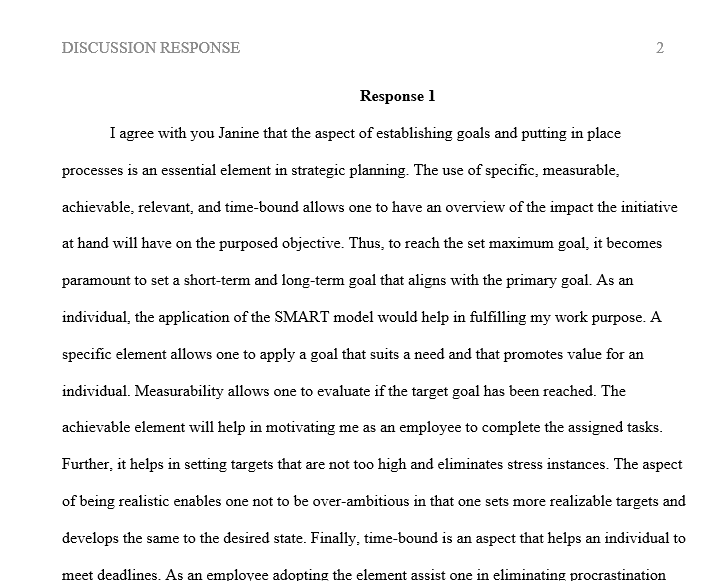Post one outcome that you feel is not SMART (or as SMART) as it can be and discuss what you are going to do to change it.
This discussion board will help you prepare for your final logic model project and gain some practice in creating SMART goals for your program.
Begin by reviewing the resources below, SMART behavior change outcome objectives.
Then, take a look at your short and long term outcomes that you will use in your logic model.
Post one outcome that you feel is not SMART (or as SMART) as it can be and discuss what you are going to do to change it.
Then, review and comment on two of your follow learners posts. Try to provide insight on what they can do to make it as SMART as it can.
Respond to at least two colleagues in one of the following ways: share an insight from having read your colleague’s posting, validate an idea with your own experience, or expand on your colleague’s posting.
(Note: You do not need to respond to the discussion questions, it is included for your reference so you are aware of what questions the students are replying to) I posted my colleagues’ responses to the discussion question above, please respond to their post. Begin the response with Hi Janine/Samantha) (I need at least a half page response) Please include references and provide the url link to all journal articles you use as references. Use current (meaning within the past 2 years) scholarly journal articles as references. Please use APA 6th edition format. Thanks)
Janine’s Post:
Setting process and outcome goals is an important, and often challenging, aspect of strategic planning. It’s tempting to make broad, sweeping statements to promote support and enthusiasm for a proposed initiative. Unfortunately, by failing to establish specific, measurable, achievable, relevant, and time-bound (SMART) objectives, it becomes much more difficult to actually reflect the impact your initiative has had on the target goal. It’s helpful, then, to set both short-term and long-term objectives to more accurately reflect progress towards your ultimate goal.
A powerful resource for prevention professionals is the Community Toolbox, https://ctb.ku.edu/
“Objectives should be S.M.A.R.T. + C.:
- Specific. That is, they tell how much (e.g., 10%) of what is to be achieved (e.g., what behavior of whom or what outcome) by when (e.g., by 2025)?
- Measurable. Information concerning the objective can be collected, detected, or obtained.
- Achievable. It is feasible to pull them off.
- Relevant to the mission. Your organization has a clear understanding of how these objectives fit in with the overall vision and mission of the group.
- Timed. Your organization has developed a timeline (a portion of which is made clear in the objectives) by which they will be achieved.
- Challenging. They stretch the group to set its aims on significant improvements that are important to members of the community. (Center for Community and Health Development, n.d.).”
As I build my logic model, one of my behavioral outcomes that could use improvement is:
Junior Marines will experience fewer alcohol-related incidents.
A revised SMART+C outcome would be:
After completing a Substance Abuse Counseling Center 4 hour alcohol misuse prevention training, Marines E-3 and below will have a 5% reduction in alcohol-related incidents in the first year of assignment to MAG-12.
Specific: Marines E-3 and below
Measurable: 5% reduction of alcohol-related incidents as reflected in annual data collected about alcohol-related incidents in MAG-12 by the Substance Abuse Counseling Center and Provost Marshal
Achievable: The Substance Abuse Counseling Center has both staff and materials and a mandatory weekly training schedule has been adopted
Relevant: Reduction of alcohol-related incidents has been set as the #1 non-warfighting priority for the III Marine Expeditionary Fleet
Timed: Within the first year of assignment to MAG-12 (the identified window of increased risk of alcohol-related incidents)
Challenging: The outcome is challenging due to the strong perceived cultural norm for alcohol misuse in the Marine Corps as part of the ‘ethos’ of the branch of service
What other suggestions might be made to strengthen the revision of this outcome?
References
Center for Community and Health Development. (n.d.). Section 3: Creating objectives. University of Kansas. Retrieved August 13, 2020, from https://ctb.ku.edu/en/
DecisionSkills. (2014, May 22). SMART goals-quick overview. Retrievedhttps://www.youtube.
Samantha’s Post:
S.M.A.R.T. objectives are defined are specific, measurable, attainable, relevant, and time specific. It is important that goals in the human services field follow this design, in order to produce solid outcomes.
Specific: Objectives should address the who, what, where, and when.
Measurable: Objectives should define a baseline and measurement.
Attainable: The objective should be something that can actually be achieved. For instance, if you’re addressing obesity, setting a goal of losing 50% of your weight in 2 months would be unrealistic.
Relevant: The objective should be relevant to the overarching goal.
Time specific: The objective should always have a time-frame of completion.
For my program, the Violation Initiative Program, set to reduce the likelihood of recidivism and avoid placement in youth involved in the juvenile justice system, there are several goals/objectives related to the youth’s level of service (YLS), including education/employment, leisure/recreation, peer relations, etc.
An objective that may not be S.M.A.R.T. within my program would be “youth will attend school daily”. There is no measurement, it is not something that is realistically achievable for a youth involved in the juvenile justice system, and it is not time specific. In order to make the objective S.MA.R.T., I would try changing it to this:
“Youth will attend an educational program, 4 out of 5 times weekly (80% of the time), for the next three months of the program.”
Solution preview for the order on Post one outcome that you feel is not SMART (or as SMART) as it can be and discuss what you are going to do to change it.
APA
351 words
